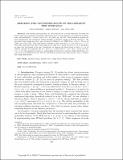| dc.contributor.author | Kaufman-Halman, Tali | |
| dc.contributor.author | Litsyn, Simon | |
| dc.contributor.author | Xie, Ning | |
| dc.date.accessioned | 2010-09-03T14:48:57Z | |
| dc.date.available | 2010-09-03T14:48:57Z | |
| dc.date.issued | 2010-02 | |
| dc.date.submitted | 2008-02 | |
| dc.identifier.issn | 1095-7111 | |
| dc.identifier.issn | 0097-5397 | |
| dc.identifier.uri | http://hdl.handle.net/1721.1/58304 | |
| dc.description.abstract | For Boolean functions that are $\epsilon$-far from the set of linear functions, we study the lower bound on the rejection probability (denoted by REJ(epsilon) of the linearity test suggested by Blum, Luby, and Rubinfeld [J. Comput. System Sci., 47 (1993), pp. 549–595]. This problem is arguably the most fundamental and extensively studied problem in property testing of Boolean functions. The previously best bounds for REJ(epsilon) were obtained by Bellare et al. [IEEE Trans. Inform. Theory, 42 (1996), pp. 1781–1795]. They used Fourier analysis to show that REJ(epsilon)[geq]epsilon for every 0[leq]epsilon [leq]1/2. They also conjectured that this bound might not be tight for epsilon's which are close to 1/2. In this paper we show that this indeed is the case. Specifically, we improve the lower bound of REJ(epsilon)[geq]epsilon by an additive constant that depends only on epsilon: REJ(epsilon)[geq] epsilon+min{1376epsilon[superscript 3](1-2epsilon)[superscript 12],[frac 1 over 4epsilon(1-2epsilon[superscript 4]}, for every 0[leq]epsilon[leq]1/2. Our analysis is based on a relationship between REJ(epsilon) and the weight distribution of a coset code of the Hadamard code. We use both Fourier analysis and coding theory tools to estimate this weight distribution. | en_US |
| dc.language.iso | en_US | |
| dc.publisher | Society for Industrial and Applied Mathematics | en_US |
| dc.relation.isversionof | http://dx.doi.org/10.1137/080715548 | en_US |
| dc.rights | Article is made available in accordance with the publisher's policy and may be subject to US copyright law. Please refer to the publisher's site for terms of use. | en_US |
| dc.source | SIAM | en_US |
| dc.title | Breaking the epsilon-Soundness Bound of the Linearity Test over Gf(2) | en_US |
| dc.title.alternative | BREAKING THE ε-SOUNDNESS BOUND OF THE LINEARITY TEST OVER GF(2) | en_US |
| dc.type | Article | en_US |
| dc.identifier.citation | Kaufman, Tali, Simon Litsyn, and Ning Xie. "Breaking the epsilon-Soundness Bound of the Linearity Test over Gf(2)." SIAM Journal of Computing (2010) Volume 39, Issue 5 : pp. 1988-2003. ©2010 Society for Industrial and Applied Mathematics. | en_US |
| dc.contributor.department | Massachusetts Institute of Technology. Computer Science and Artificial Intelligence Laboratory | en_US |
| dc.contributor.department | Massachusetts Institute of Technology. Department of Electrical Engineering and Computer Science | en_US |
| dc.contributor.approver | Kaufman-Halman, Tali | |
| dc.contributor.mitauthor | Kaufman-Halman, Tali | |
| dc.contributor.mitauthor | Xie, Ning | |
| dc.relation.journal | SIAM Journal of Computing | en_US |
| dc.eprint.version | Final published version | en_US |
| dc.type.uri | http://purl.org/eprint/type/JournalArticle | en_US |
| eprint.status | http://purl.org/eprint/status/PeerReviewed | en_US |
| dspace.orderedauthors | Kaufman, Tali; Litsyn, Simon; Xie, Ning | en |
| mit.license | PUBLISHER_POLICY | en_US |
| mit.metadata.status | Complete | |
